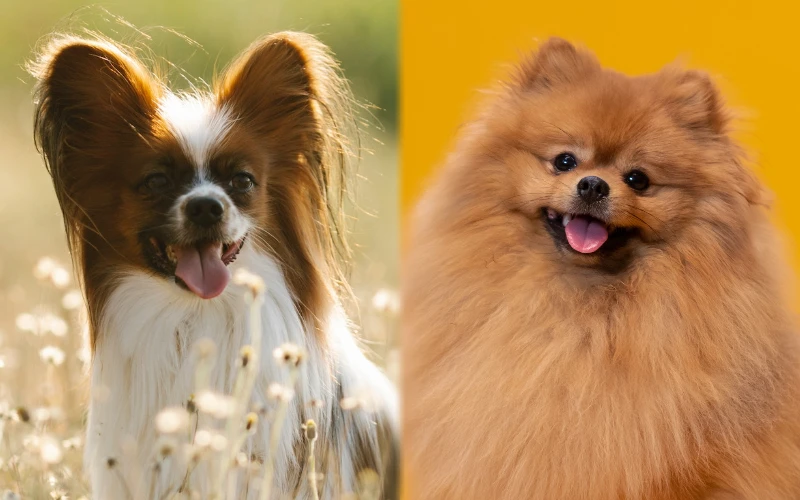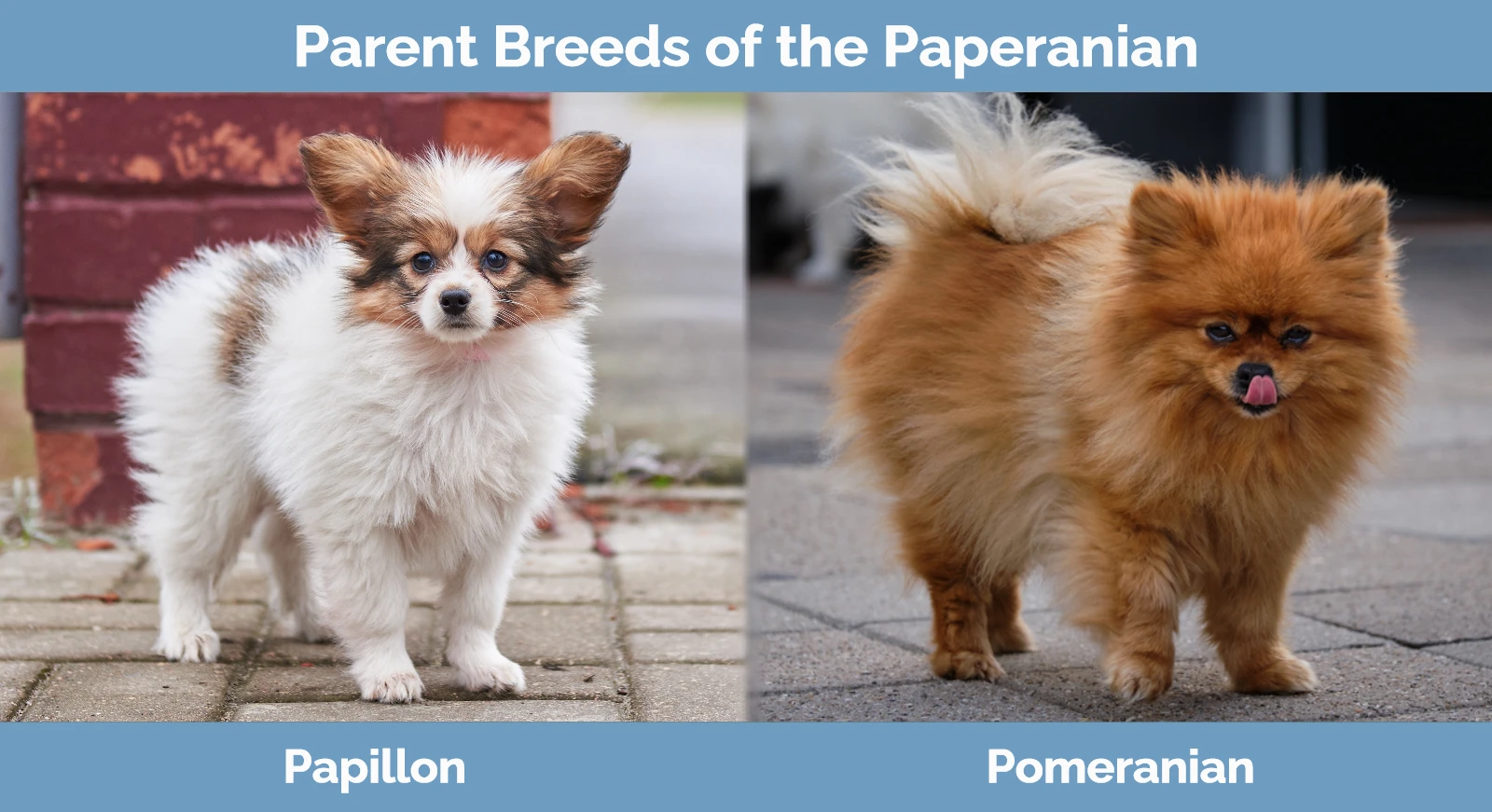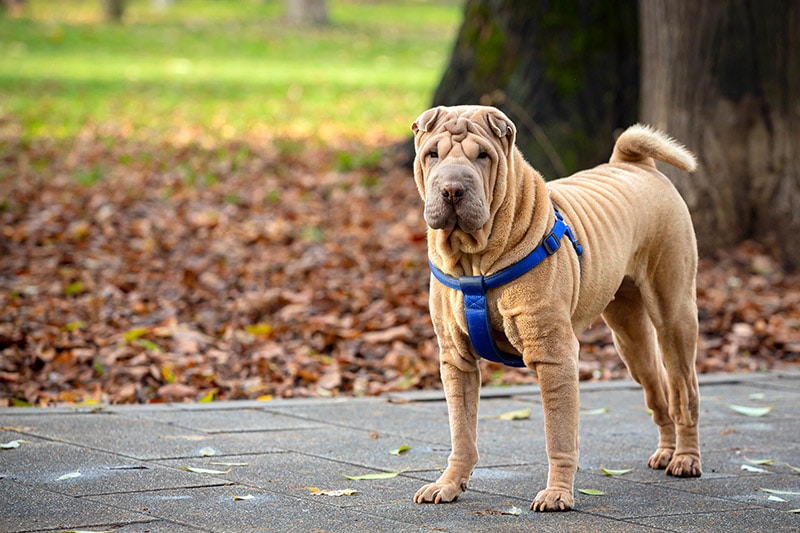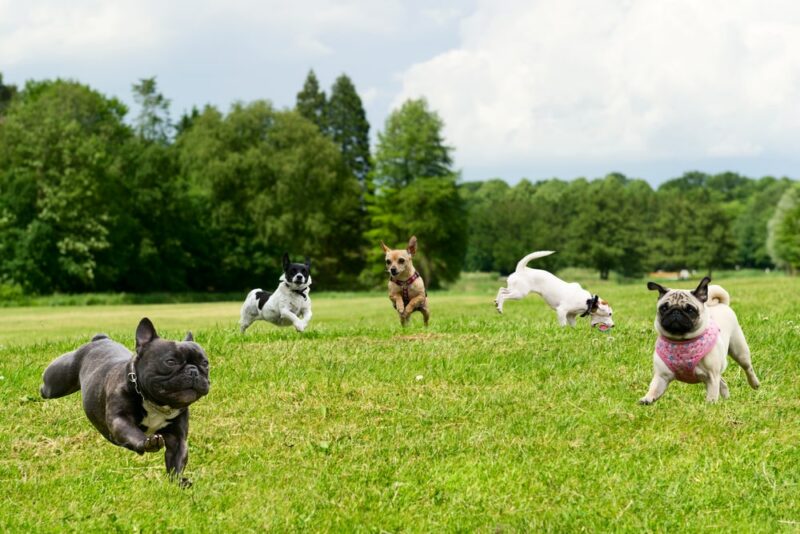Paperanian (Papillon Pomeranian Mix): Pictures, Care Guide, Temperament & Traits

Updated on

Click to Skip Ahead
Pairing the Pom and the Pap, the Paperanian draws together two of the canine world’s biggest personalities in one of its smallest packages. Though many choose them for their unique qualities, the parent breeds share several personality traits that are a joy to have around the house.
Paperanians are dependably outgoing, animated, and curious, and they’re an intelligent breed with a zest for life and deep love for their family. Discover why this remarkable mix is a natural fit in any home as we look at the Paperanian’s care, temperament, and traits.
| Height: | 6–11 inches |
| Weight: | 3–10 pounds |
| Lifespan: | 12–16 years |
| Colors: | Blue, black, chocolate, tan, cream, sable, orange, red, white |
| Suitable for: | Families with older children, seniors living alone |
| Temperament: | Happy, intelligent, friendly, alert, active, adaptable |
The Paperanian’s parents have a lot in common, making the designer dog fairly predictable in physique and personality. A pair of dainty toy dogs, the Papillon and Pomeranian, have been pets among elite circles for generations. Nobles prized the Papillon for hundreds of years for their cute looks, small size, and affectionate nature, making them perfect lap warmers.
Papillons arose from Toy Spaniels and Poms from purpose-bred Spitz dogs. Many of their ancestor’s traits hold strong in these modern companion animals. They are extremely intelligent dogs and highly trainable. And despite the delicate bodies and leisurely lifestyles they traditionally lead, the working background of their forebears make them some of the most spritely, athletic, and entertaining breeds.
Paperanian Breed Characteristics
Paperanian Breed Puppies
Paperanian puppies will grow into well-behaved and affable pets with training and socialization. Housebreaking can be an arduous process, as is expected with smaller dogs. Their tiny bodies have trouble holding their bladders, so expect more accidents. When it comes time to establish a routine, they may also have issues adapting to you being away.
Socialization is an essential part of raising a Paperanian. Poms and Paps can often take domineering stances towards other dogs, even larger breeds. They are also wary of strangers, delivering a confident bark when they feel nervous or suspicious. Though they make good watchdogs, a vocal dog may not be ideal for every setting. Proper introductions and frequent exposure to varying situations in and out of the home will help them stay calm and less defensive around strangers.

Temperament & Intelligence of the Paperanian 🧠
Paperanians boast a spirited yet adaptable personality to suit a broad spectrum of owners. The affectionate mix loves cuddles as much as playtime and is always willing to follow their owner’s lead if it means staying by their side. Cute, clever, and capable, these small dogs are easy to train, despite the Pomeranian disposition towards stubbornness.
Are These Dogs Good for Families? 👪
Paperanians are exceptional with families, though you must take caution with large animals and small children. With their fragile frames, they can easily injure from rough handling and play. If they’re well-trained, kids can be an excellent match for the big-hearted and lively dogs.
Does This Breed Get Along With Other Pets?
Paperanians generally work well with other pets but may also inherit some standoffishness from their parent breeds. Papillons get along swimmingly with cats and dogs with proper socialization. Pomeranians may show a bit of an aggressive or jealous attitude toward other dogs, especially strangers making them feel threatened.
Early guided introductions to other household pets and frequent socialization opportunities can help a Paperanian’s anxiety. Due to the potential for undesirable interactions with larger animals, many recommend pairing them with smaller dogs like Shih Tzus, Poodles, Corgis, and Maltese. No matter the other pet in the house, training alongside spaying and neutering will keep your Paperanian well-mannered and relaxed around other pets.
Things to Know When Owning a Paperanian:
Food & Diet Requirements 🦴
Adult Paperanians require only about ¼–½ cups of food daily. The dog food should have high-quality protein as its leading ingredient and include a balance of natural nutrient sources. You may wish to focus on added supplements such as omega-3 fatty acids for healthier skin and fur or probiotics for improved digestion.
Discussing your pet’s specific challenges and life stages with your vet will help you stay in sync with your growing dog’s nutritional needs. As a toy dog, Paperanians will also be more susceptible to hypoglycemia. They need ample food at a reasonable and consistent frequency to keep them from suffering the ill effects of low blood sugar.
Exercise 🐕
Being tinier dogs, Paperanians don’t need much daily activity. They’re energetic enough to handle a long walk, but two short strolls for about 15 minutes will satisfy their exercise needs. Paperanians can burn calories inside or outdoors, making them versatile across numerous types of owners and housing situations. A respectable supply of toys and activities will occupy their busy minds, which is a critical aid when you need to leave for the day.
Training 🎾
The sporting lineage in the Papillon is a help to training, while the impish Pom side can sometimes keep your leadership in check. Papillons and Pomeranians are highly intelligent, ranking 8th and 23rd on Coren’s list of most intelligent dog breeds. They’re receptive and quick to learn, capable of doing tricks, and excel in numerous fields, from obedience competitions to therapy work.
The potential is high, but Paperanians make you work to make them well-trained. They require persistence, patience, and a firm yet gentle hand. Positive reinforcement and rewards go a long way. Short sessions will make training more effective by keeping your Paperanian engaged and relaxed.
Grooming ✂️
Paperanians aren’t hypoallergenic, but their parents have relatively manageable grooming needs. Papillons and Pomeranians rarely drool, and though they have distinct coat types, neither is overly demanding.
Whether they receive the Papillon’s silky coat or the Pom’s long, fluffy double coat, you can maintain a Paperanian with a few weekly brushes and a bath every 2–3 weeks. Teeth brushing should occur every 1–2 days. Eyes and ears need weekly checks and cleanings, while nails need frequent trims to prevent awkward pressure on the paws.
Health and Conditions ❤️
Papillons and Pomeranians are reliably long-living dogs, ensuring a positive outlook for their offspring. While many might consider a mix even healthier, it can predispose them to either parent’s unique concerns.
- Patella Luxation: The kneecap is misaligned and randomly slips out of place, causing mild to severe discomfort
- Cataracts: Eyes develop a cloudy haze, affecting vision
- Collapsed Trachea: A narrowed trachea causing breathing problems, wheezing, and honking
- Progressive Retinal Atrophy: The slow failure of the retina, leading to eventual blindness
- Severe Hair Loss Syndrome: Gradual hair loss and darkened skin resulting from one of several possible disorders, infections, or allergies
- Cryptorchidism: A male dog’s testicles don’t descend properly during growth, a potentially painful condition
- Von Willebrand’s Disease: A genetic blood clotting disorder
- Patent Ductus Arteriosus (PDA): A congenital defect causing an enlarged heart and increasing the risk of failure
- Heart Disease: Weakening heart muscles that typically develop later in life
Male vs Female
Male and female Paperanians provide similar benefits to the household, but many insist that they have distinct personality traits. Males are often more energetic, playful, and affectionate, while females are independent and potentially more aggressive. Still, all dogs are unique, and generalizations based on sex usually aren’t worth following. Training, socialization, and history are the most critical factors in determining a Paperanian’s temperament.
3 Little-Known Facts About The Paperanian
1. Paperanians Are Incredible Athletes
Of the many traits Pomeranians and Papillons share, their footwork is one of the most impressive. Paperanians may not make it into the conformation show, but they’re perfect specimens for agility. Pomeranians and, to a greater extent, Papillons are incredibly nimble and fast. They can execute lightning-fast turns, speed across precarious ramps, and bounce between poles as if they’re barely touching the ground. The agility course takes advantage of the Paperanian’s superior intelligence and astounding athleticism in a fulfilling bonding opportunity for you and your pet.
2. The Paperanian Coat Comes in All Colors
The delightfully plush, silky hair on the Paperanian is one of the crossbreed’s best features. Paperanians come in a multitude of colors due to their mixed parents. You can get black, lemon, red, and other colors mixed with white, as is typical with Papillons. Or you may see any of the Pom’s many hues, including orange, cream, beaver, chocolate, and blue. You could even luck out and find a tricolor or rare merle pattern.
3. Paperanians May Go By Another Name
Paperanian may be the more common moniker but don’t be surprised if you hear the term “Papi Pom” thrown around. The more informal nickname is well-accepted and, with fewer syllables, easier to use in casual conversation.
Final Thoughts
Unless you love big dogs, there’s no reason to count out the Paperanian as your next pet. They’re incredibly adaptable and capable of flourishing in hot weather, cold climates, cities, or the countryside. Highly biddable, eager to please, and boasting the perfect amount of energy, they can be as laid back or active as you need. Almost any family or individual owner can appreciate this adorable pup, and they’re guaranteed to bring many years of love and laughter to the home.
Featured Image Credit: Left – Blue Bird, Pexels | Right – KoolShooters, Pexels












